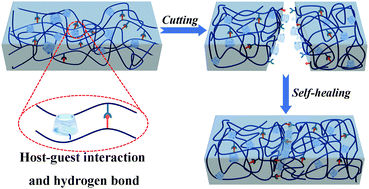A highly efficient bionic self-healing flexible waterborne polyurethane elastic film based on a cyclodextrin–ferrocene host–guest interaction†
Abstract
The preparation of flexible elastomer materials with favorable mechanical properties and bionic self-healing abilities is still a current challenge. Herein, a novel ferrocene-diol (Fc-diol) was synthesized and incorporated into waterborne polyurethane (WPU) chains with methylated β-cyclodextrin (Me-β-CD). A series of waterborne polyurethane chains with different loading molar ratios of ferrocene (Fc) to cyclodextrin (CD) were fabricated successfully. Repair experiments showed that the best self-healing effect of WPU-Fc/CD was obtained when the molar ratio of Fc to CD was 2 : 1, as it showed an almost 100% repair effect for scratches and a high healing efficiency (98.54%) for completely broken wounds. UV titration, VT-FTIR and 1H–1H NOESY NMR spectroscopy results demonstrated that a synergic effect between the host–guest interactions and hydrogen bonds enabled them to be constructed successfully. Therefore, the scratches of the WPU-Fc/CD film could be repaired effectively based on this synergic effect. Furthermore, the film also exhibited ∼10.85 MPa of tensile strength and an elongation of 470.85%. WPU-Fc/CD hybrid films that are silver loaded can be employed as flexible conductive films for circuits, and the results indicated that they have great potential applications in electronic skins, flexible sensors, bionic devices, etc.



 Please wait while we load your content...
Please wait while we load your content...